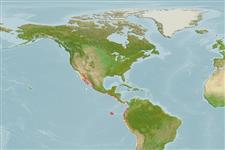Classification / Names
Common names from other countries
Main reference
Size / Weight / Age
Max length : 99.0 cm FL male/unsexed; (Ref. 40637); common length : 60.0 cm FL male/unsexed; (Ref. 168); max. published weight: 8.2 kg (Ref. 4699)
Length at first maturity
Lm ?, range 26 - 32 cm
Environment
Marine; pelagic-neritic; oceanodromous (Ref. 51243); depth range 10 - 60 m (Ref. 91172)
Climate / Range
Tropical, preferred 27°C (Ref. 107945); 33°N - 27°S, 121°W - 70°W (Ref. 168)
Distribution
Eastern Central Pacific: La Jolla in southern California, USA to the Galapagos Islands and Paita, Peru. Recently reported from Antofagasta, Chile. Many authors have erroneously considered this species to be a synonym of Scomberomorus maculatus, or a subspecies of it.
Countries | FAO areas | Ecosystems | Occurrences | Introductions
Short description
Dorsal
spines
(total): 15 - 18;
Dorsal
soft rays
(total): 16-19;
Anal
soft rays: 16 - 21;
Vertebrae: 46 - 49. Interpelvic process small and bifid. Body covered with small scales. Lateral line gradually curving down toward caudal peduncle. Intestine with 2 folds and 3 limbs. Swim bladder absent. Pelvic fins relatively long. Sides silvery with numerous round brownish (orange in life) spots, three rows above lateral line, one above. The first dorsal fin is black distally and white at the base. The second dorsal fin is tinged with yellowish and with black margin. The anal fin is white.
IUCN Red List Status (Ref. 115185)
Threat to humans
Harmless
Human uses
Fisheries: commercial; gamefish: yes
More information
ReferencesAquacultureAquaculture profileStrainsGeneticsAllele frequenciesHeritabilityDiseasesProcessingMass conversion
Tools
Special reports
Download XML
Internet sources
Estimates of some properties based on models
Phylogenetic diversity index
PD50 = 0.5000 many relatives (e.g. carps) 0.5 - 2.0 few relatives (e.g. lungfishes)
Trophic Level
4.5 ±0.8 se; Based on diet studies.
Resilience
Medium, minimum population doubling time 1.4 - 4.4 years (Assuming tm=2-4)
Vulnerability
Moderate vulnerability (39 of 100)
Price category
